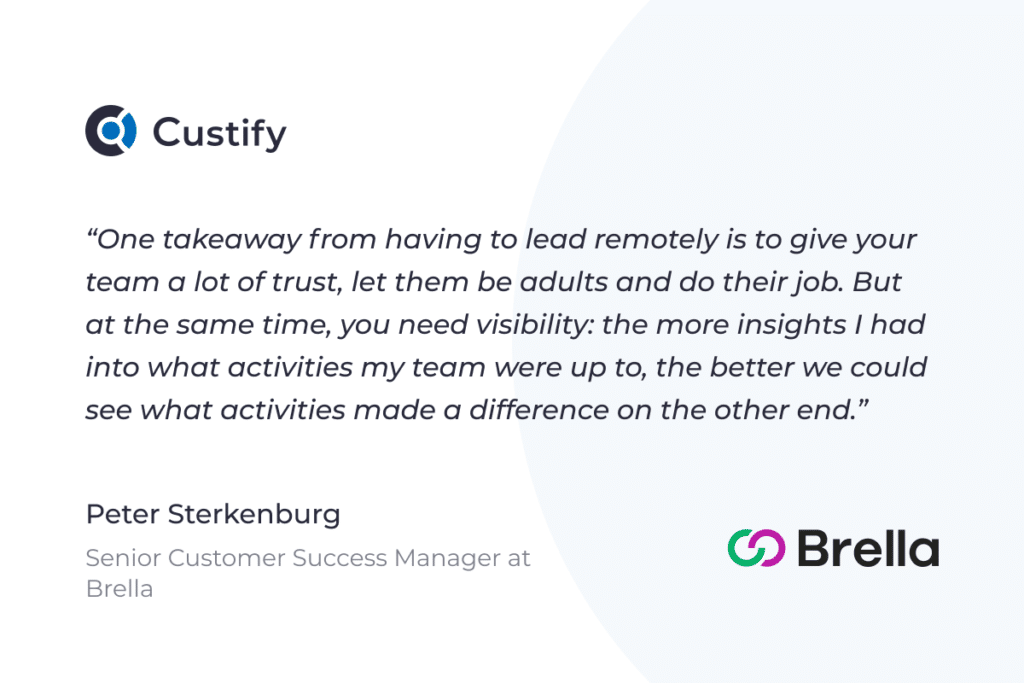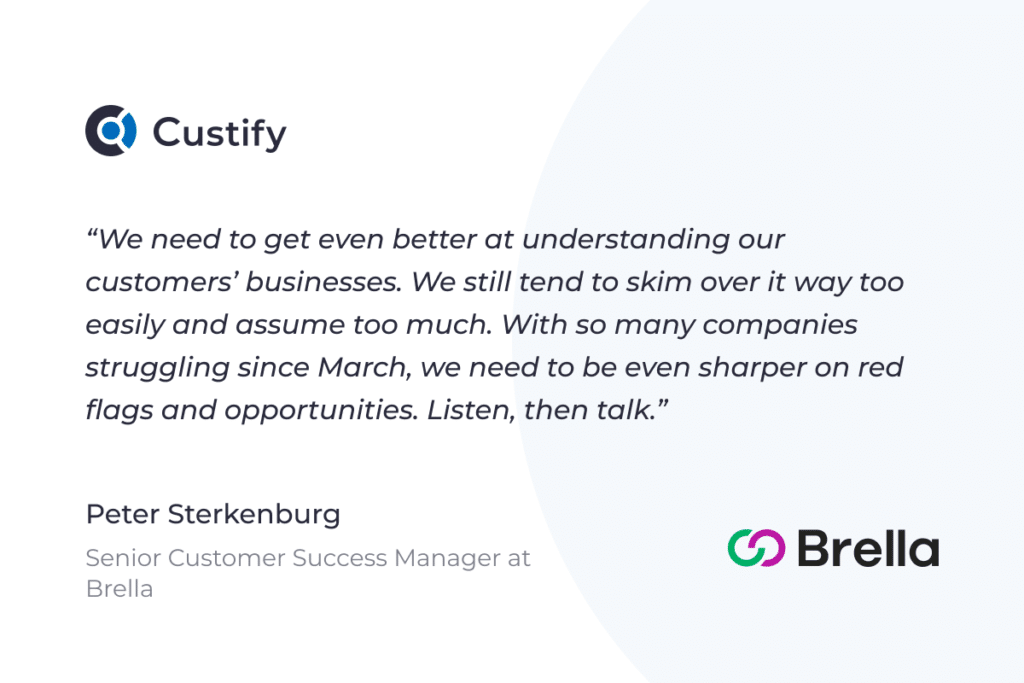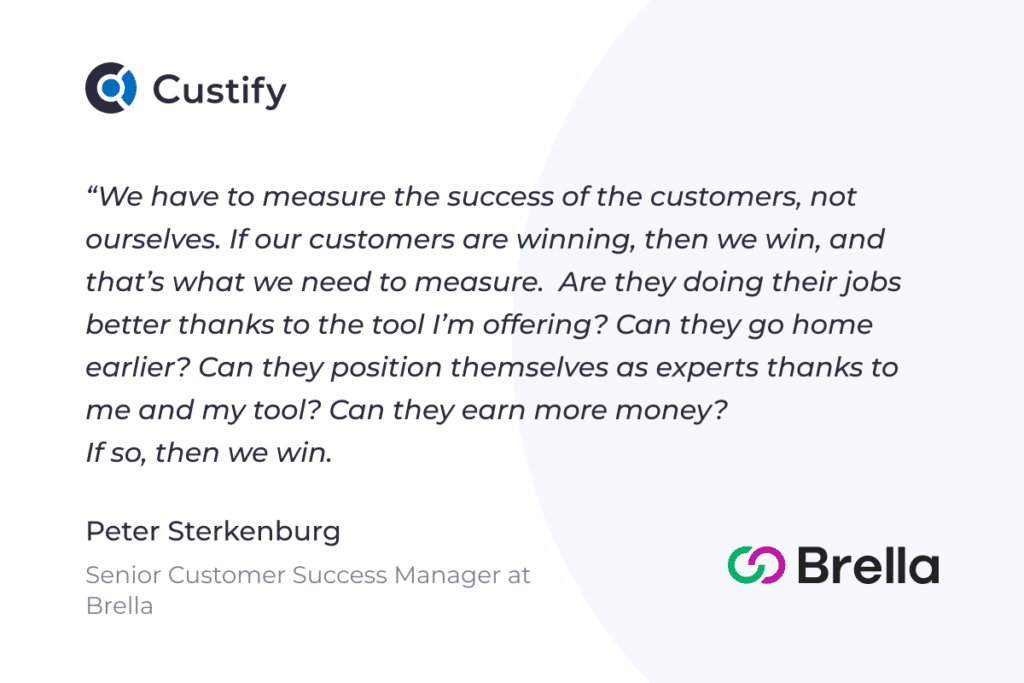At Custify, we love sharing what we’ve learned in the last 19+ years in the Customer Success industry. However, this time we thought we’d do something different and put a spotlight on other professionals’ experiences.
Peter Sterkenburg is a veteran in this field. He comes from a Support background, but his business skills enabled him to switch to Customer Success as this new role emerged.

Since then, he’s worked with numerous B2B SaaS startups in the Netherlands, Denmark, and Finland, he’s a consultant for Nordic and pan-European Seed / Series A tech startups and scaleups, and recently, he has become a Senior Customer Success Manager at Brella – an AI-powered event platform. Their company has been extremely focused on their customers’ success from day 1, and their CS team is the biggest one in their organization.
We’re extremely excited Peter has accepted our invitation to share his experience with us. Below, you’ll find 8 Customer Success best practices he’s learned in his career, in no particular order:
1. Bring clarity to your Customer Success efforts
Pre-seed and Series A startups (although this can be applied to any company, really) should focus on having clarity in their Customer Success efforts. This means looking beyond the confines of the Customer Success team.
“Many companies say they’re customer-focused, but in reality, they’re far from it. Founder ego, internal politics, and a lack of understanding of customer centricity are generally core elements.”
2. Trust your Customer Success team
While at Leadfeeder, Peter experienced first hand what managing a team of 12 across 6 time zones looks like. So if you’re a Customer Success Manager in a similar position (especially now, because of the pandemic), just know that it is possible. Here’s how he’s done it:
“Our tooling was deeply integrated with everything else. We constantly tried to have every tool work with everything else and had dedicated resources to deal with that in the company. This made a lot of automation possible and influenced processes a lot. As for engagement processes, they were an ongoing challenge, but we tried through active segmentation to focus our efforts.
As time went along, we got more and more data-driven, which helped us dig into ‘unknown’ segments and be even more specific. We got to use a customer success software in the end, which helped greatly in gaining more insights into our own efforts and the customers’ success.”
“One takeaway from having to lead remotely is to give your team a lot of trust, let them be adults and do their job. But at the same time, you need visibility: the more insights I had into what activities my team were up to, the better we could see what activities made a difference on the other end.”

3. Focus on your time management skills
Customer-facing representatives are managing multiple customers at various stages of the customer lifecycle. They have a lot on their plate, so they need excellent time management skills. Otherwise, they’ll get buried in their to-do list. The same goes for CS leaders: improving on your processes, tooling, and data, is neverending. Boil your vision down to actionable elements, because:
“Dealing with the sheer amount of things that need to be done and thought out can be quite daunting. It’s intimidating to see a to-do / wish list that can easily take you 2 years to complete.”
4. Be aware of your team’s mental health and engagement
Because of the pandemic, most companies have been forced to operate remotely. Some people already had experience with this, so the transition was very easy. But others struggle, and it’s your job as a manager to check in on them and make sure they’re ok.
Mental health issues can definitely become more pronounced when physically removed from colleagues, and the biggest challenge for managers is to be even more aware of what’s going on.
“At Leadfeeder, everyone worked remotely (it’s a remote-first organisation), so I had been used to it for several years already. Now, at Brella, a lot of people are working remotely as well as per the Finnish government recommendations.
It works better for some than for others, but overall, I see most people thriving, being more focused on singular tasks, and delivering higher quality. Yes, we all miss the social aspect, but the pros still outweigh the cons. As a parent as well, I have to say, working from home has been great: focusing on work makes me more productive, which gives me more time to do mundane tasks like laundry and shopping.”
5. Learn how to ask the right questions
Data shows that top companies today use an average of 37 different tools or software platforms to run their day-to-day operations. This means that your customers are not yours alone – they’re talking to CS reps from other companies all the time, and you have very limited time and opportunities to impress them. You need to understand their business as well as they do, and for that, you need to take your question-asking skills to the next level.
“We need to get even better at understanding our customers’ businesses. We still tend to skim over it way too easily and assume too much. With so many companies struggling since March, we need to be even sharper on red flags and opportunities. Listen, then talk.”

6. Customer Success is not a glorified support department
We’re so glad Peter touched upon this subject! As you well may know, we’ve previously covered the Customer Support vs. Customer Success subject as well. While the first one is reactive, the other is proactive. They’re both indispensable to your business, but now more than ever, because of the economic uncertainty that looms ahead, great Customer Success will make a difference between thriving companies and declining ones.
“We’re in the middle of planning for the future: a better onboarding process and less friction for our customers. In the context of economic uncertainty, we want to provide certainty and trust. If we make our customers successful, their stress levels will go down.
On the whole: no, Customer Success won’t be more difficult in the future. Not for the ones who understand customer-centricity. Those who still consider Customer Success a glorified Support department will surely have bigger problems.”
7. Know more about a product than its customers
Before the pandemic, Peter and his team were working on a product designed for offline events. Fast forward a few months, and such events weren’t possible anymore. They could have called it quits, or they could’ve pivoted and turned the situation into an opportunity instead. Which they did. This is a real-life business lesson!
“Brella made the pivot within 2 months from being a networking tool for in-person events to a networking tool for virtual events platforms, with a whole streaming component added. The whole team had to learn about streaming services and such, as our customers often knew even less about it. The success that came after the hard work has been well-deserved: the company is now growing and prospering”
8. Measure the success of your customers, not the success of your Customer Success department
Measuring the ROI of your CSMs is a hot industry topic right now. We have two articles dedicated to this subject on our blog, but we’re always interested in seeing how other companies approach this:
“My personal view is that it’s a wrong metric: we have to measure the success of the customers, not ourselves. If our customers are winning, then we win, and that’s what we need to measure.
Are they doing their jobs better thanks to the tool I’m offering? Can they go home earlier? Can they position themselves as experts thanks to me and my tool? Can they earn more money? If so, then we win.

Additionally, often, it’s not clear what ROI actually is. This comes from badly defining and understanding what Customer Success is (across the organization), and what the intended value is that we bring to our customers. If we don’t know what we offer, then how are we going to measure our ROI? (Tip: endless days of training users on how to use your tool is not the answer)
Start by defining very sharply what services Customer Success reps offer, and what’s not equally important. “Plan accordingly: how much time and what resources does your team need to offer to achieve the highest value at any given milestone? Optimize regularly and find a baseline in terms of capacity planning. Then, you start to get a picture of the ROI your team delivers.”
To wrap it up, we think Customer Success is still in its early days. As the industry matures, we as CSMs learn new things about our jobs and our customers, and tools are constantly improving to give us the insights we need (and as many as we need).
2021 will be the year of smarter digital-first engagement – not ‘tech-touch’ in the classical sense, but a smarter mix of standardized and personalized engagement, with digital as the carrier.
We hope you found these Customer Success best practices useful (we ourselves learned a thing or two from Peter), and let us know whether you enjoy these honest talks with industry professionals and what other topics you’d like us to tackle next. Until next time!




